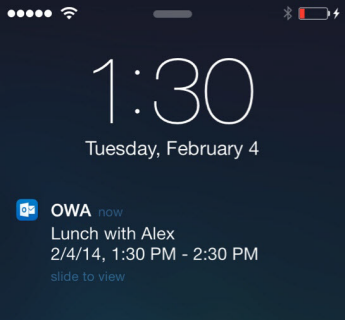*** For information on how to setup Outlook on your mobile device, go to the "Mobile Apps & NIC" tab on the left, or go here***
Important: If you’re on a mobile device, for the best experience we recommend that you install the latest Microsoft app for your device: Outlook for iOS or Outlook for Android.
If you have an Office 365 for business or education account, or if your organization uses Exchange 2013, you can use OWA for iPhone and OWA for iPad to access your email, calendar, and contacts. The app looks and feels like signing into your account using Safari, without having to enter your user name and password each time. The app adds features that you won’t see when signing in through Safari, such as contact sync, reminders, and new message notification.
When you first launch the app, you’ll be asked to enter your Office 365 name and password, which are then stored on your device.
Why use Outlook for Mobile? 
Tired of signing on to myNIC to check your email? Outlook for mobile supports offline access to your email, calendar, and contacts. The most recent items are downloaded to your device every time you use the app while online. While offline, you can read and respond to downloaded messages and meeting requests. You can also create new messages, calendar items, and contacts. When you first install the app, you will see Setting up this app to work offline. This may take a few minutes at the bottom of the screen. Next you will see This app is ready to use offline. From then on, every time you use the app while you’re online, it will update the offline information.
Outlook for mobile also offers notifications which can be set according to your needs.

You can learn about setting other options at this link: Outlook Web App options on a mobile device.
What if I want to know more?
-
Offline synchronization copies message information from the previous three days, plus one month of past and up to six months of future calendar information. If you have more than 750 future calendar items in six months, only three months will be synchronized.
-
In addition to your Inbox, Drafts, Contacts, and Calendar, five other message folders that you’ve used recently will be synchronized for offline access. Which folders are synced will change depending on how often you access them. As an alternative, you can select up to five message folders to sync. Each folder that you choose will take the place of one of the five that would have been automatically synced.
-
If you’ve synchronized your contacts with your device and have your device configured to synchronize with iCloud, your contacts will also be synchronized with iCloud.
-
If you stop Contact sync while your device is configured to synchronize with iCloud, the contacts synchronized through Contact sync will be removed from your device and from iCloud.
-
If you stop iCloud synchronization but continue Contact sync, you’ll be given a choice to keep the contacts synchronized through Contact sync in iCloud, or remove them. If you keep them in iCloud, and later stop Contact sync, the contacts will remain in iCloud.
-
You can’t sign out from OWA for iPhone or OWA for iPad. To remove your sign in information and any downloaded content, remove the app from your device.
-
For information about how to connect to your account using the email, calendar, and contacts apps that come preinstalled on your devices, see Set up email on Apple iPhone, iPad, and iPod Touch.
-
To learn more about the app, see the blog post that introduces and describes OWA for iPhone and OWA for iPad.
-
If you have an Office 365 account see Office 365 mobile setup - Help for information about how to use Office 365 on your phone or tablet.





